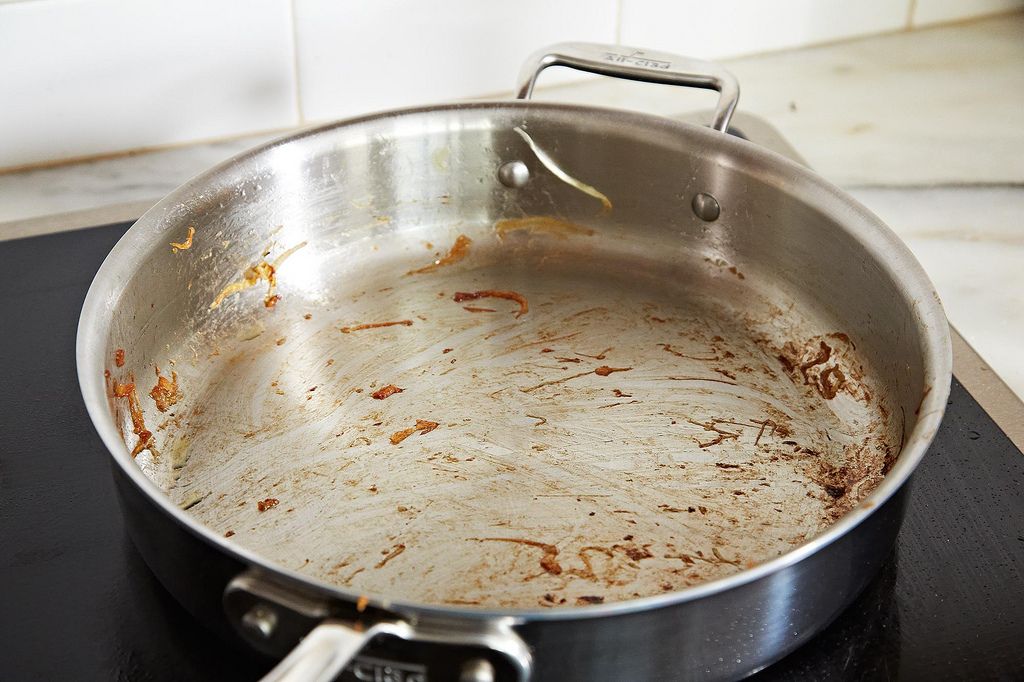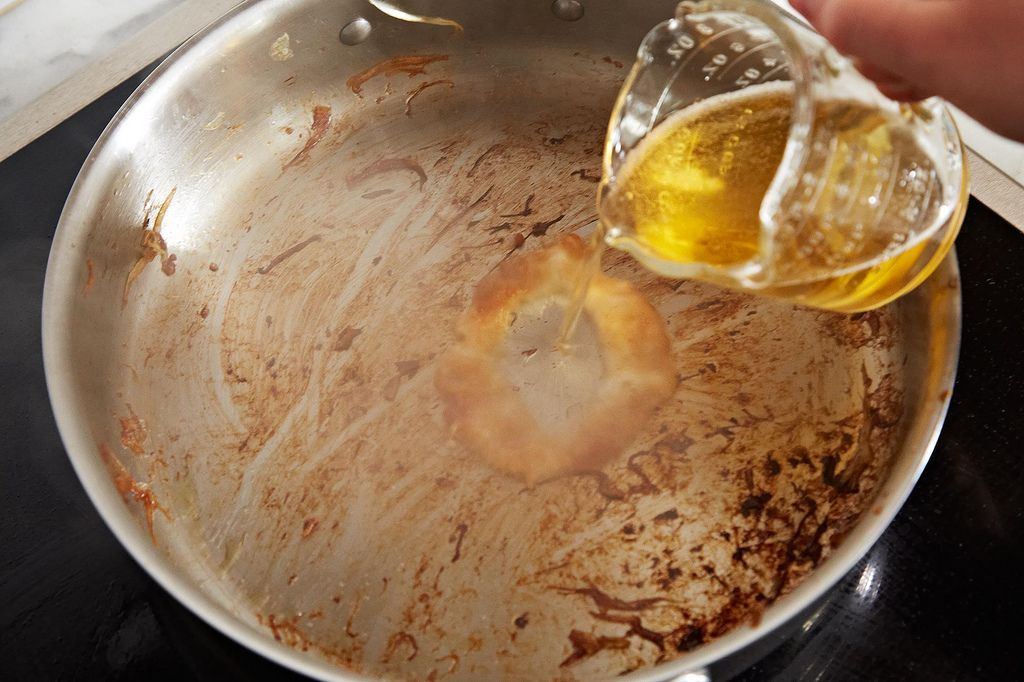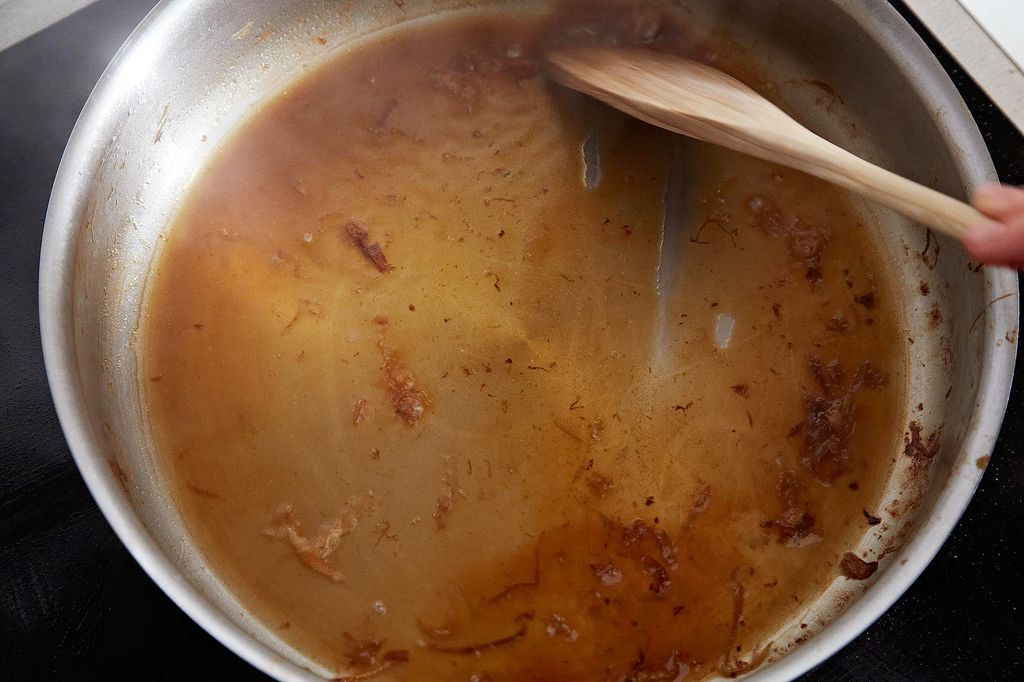Inspired by conversations on the Food52 Hotline, we're sharing tips and tricks that make navigating all of our kitchens easier and more fun.
Today: Don't wash away them most flavorful bits in your pan. They're called fond, and they're the start of a very good pan sauce. Here's what you need to know.
Picture this: You’re frying chicken breasts, maybe pan-searing a porterhouse steak. You’re basting it with rosemary- and garlic-infused browned butter, letting the caramelized, fatty butter coat the juicy meat. You remove said chicken or steak from the pan (ideally you’re using stainless steel or cast-iron) and see that there are all of these little browned bits stuck to the bottom of the pan. These caramelized bits, also known as fond, are culinary gold. They’re packed with so much flavor and are the base for gravy, or a red wine or white wine pan sauce.
What Is Fond?
In the universe of cooking, fond is the dark matter. Undetectable in a finished dish, these concentrated brown bits may seem small, but the impact they have on flavor is huge. Fond, quite simply, is the stuff that sticks to your pan after browning meat or vegetables on the stove top, or at the bottom of a roasting pan after it has come out of the oven. Pour off the oil or any remaining cooking liquid, and these stuck little bits will remain, daring you scrub to them away—but if you’re a smart cook, you'll turn them into a rich, lip-smacking pan sauce.
How Does Fond Form?
A quick note about the pronunciation and definition of fond: “Fond” (pronounced fahn) is literally translated to mean "the bottom" or "base." In classical French cooking, the word is also used to mean "stock," another common base for various recipes. Fond is formed when proteins are exposed to heat, turning food that was once tender and pink into something crusty and brown. Chemists call this process the Maillard reaction, wherein a rainbow of chemicals erupt from the denatured proteins, unlocking flavor combinations that humans are hard-wired to find irresistible. Though similar, caramelization happens at a higher temperature than the Maillard reaction and to sugars instead of proteins. That being said, the two reactions often work together when both sugar and proteins are present.

However they find themselves there, these tasty bits are at the core of classical cooking. Of the five mother sauces that culinary school hopefuls memorize, at least three are based on fond and the technique known as deglazing—these include velouté, espagnole, and sauce tomate. Deglazing reintroduces fond to liquid, loosening and dispersing all of those concentrated flavors back into your dish. Flavor the fond with the addition of an aromatic or two—such as shallots or garlic—thicken it with flour, tomato, or vegetables, and you have the blueprint for hundreds of sauces and gravies.


How to Make a Pan Sauce
For a simple pan sauce, return the fond-encrusted hot pan to a medium-high or high heat. Use a wooden spoon to scrape the bottom of the pan and start to release the fond. Add minced onion, shallots, and/or garlic, and when the liquid from these begins to cook away—before you burn them!—add liquid (think: white wine for chicken, red wine for steak, tequila and lime juice would be delicious for chicken or bourbon for pork chops, but stock or water work just fine too, if that’s what you have). The acidity from the wine will help release the caramelized bits from the bottom of the pan; the alcohol will cook away during this process but you could also use a squeeze of lemon juice or a tiny splash of good-quality vinegar as a substitute. Scrape up the bits of fond into the bubbling deglazing liquid. After a minute or two, add a cup of water and deglaze again until the sauce is reduced by two-thirds. It should look thick, have a rich brown color, and resemble syrup or gravy.
From dirty pan to a delicious sauce, the cooking process should take about five minutes—well worth it for a major upgrade to a piece of meat.

The Best Pans for Your Pan Sauces
When it comes to cookware, some pans are more conducive to fond than others. Enamel-coated cast iron, in particular, gives great fond. And be sure that your scraping is done with a wooden spoon or similarly soft utensil like a silicone spatula, especially if you are using non-stick pans. No pan sauce calls for bits of Teflon and by using a metal utensil against a nonstick coating, you risk scratching the coating (most nonstick pans are made without the harmful coating these days but still, why ruin a pan when you don’t have to?).
It's also important not to crowd your pan; when browning, give your protein or vegetable enough room to develop a healthy crust. Overcrowded pans, like overcrowded elevators, beget sweat and steam. You won’t get fond under these spa-like conditions.
When roasting a bird or other large piece of meat, you can maximize the fond by loading your roasting pan with some onions, carrots, and celery and perching the protein above it. As the meat cooks, releasing fond-laden juices, the vegetables will caramelize, adding aroma and depth. In this case, your pan sauce is essentially done. Deglaze with wine or even water, and you’ll never bid fond farewell again.
Additional recommendations from Food52 editors:
When it comes to pan sauces made from fond, most start with meat—you can't always replicate those drippings with plant-based fat. If you’ve never turned fond into sauce before, making pan sauce from roast chicken drippings is an easy way to start, as you’ve done most of the work already. Merrill’s roast chicken, served with garlicky, herby pan sauce comes together by plopping the chicken-roasting pan directly onto the stove, to which butter, thyme, wine, and garlic are added. Chrissy Teigen has a recipe for an even quicker version, though the sauce has a few more ingredients: meet her Crispy-Skinned Chicken With Lemon-Rosemary Pan Sauce, made with seared, then oven-finished bone-in chicken breasts; to the fond, she adds garlic, red pepper flakes, rosemary, broth, heavy cream, and lemon juice.
Steak is another simple fond-producing meat that makes for pan sauces so good you may feel compelled to lick the searing-hot pan, like this salty-sweet brown sugar, fish sauce, and lime butter version served over a single-serving strip steak or ribeye. Or maybe a classic Steak au Poivre, made with shallots, black pepper, Cognac, and cream is more your speed? And when feeding a crowd, there may be no simpler fond-based sauce than this standing rib roast’s: just red wine, plum jam, butter, and pan drippings.
But guess what? You don’t actually need a piece of meat, nor their drippings to generate fond for pan sauce—butter or oil, heat, and some kind of vegetable will do the job, best served over pasta. As is the case with this fennel pasta, where you’ll caramelize onions and fennel in oil, then stir in white wine and cream. This creamy mushroom pasta is similar; instead, just make the fond with portobello mushrooms and butter, and finish with balsamic vinegar. Or this beyond simple braised onion sauce recipe, made with just butter-caramelized onions, salt, and Madeira.






See what other Food52 readers are saying.